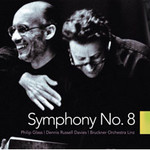
Symphony No 8
 $40.00
Out of Stock
$40.00
Out of Stock2-4 weeks add to cart
PHILIP GLASS
Symphony No 8
Bruckner Orchester Linz / Dennis Russell Davies
[ Orange Mountain Music / CD ]
Release Date: Tuesday 25 March 2008
This item is currently out of stock. We expect to be able to supply it to you within 2 - 4 weeks from when you place your order.
"(Symphony no. 8) is about continuous change...the chromaticism that has crept into Mr. Glass' music since 'Koyaanisqatsi' is now more extreme, and more fluid. Indeed, the great attraction of the work is the unpredictable orchestration."
(New York Times)
"Symphony No. 8 represents a return, after a number of major works, to orchestral music where the subject of the work is the language of music itself, as in the tradition of the 18th and 19th century symphonies. To elucidate briefly:
Symphony No. 5 is an extended work for chorus, vocal soloists and orchestra with texts drawn from the traditional religious and wisdom traditions.
Symphony No. 6 is based on a major poem, "Plutonian Ode," by Allen Ginsberg and was composed for soprano and orchestra.
Symphony No. 7 "A Toltec Symphony", is based on the indigenous traditions of Mexico and includes extended passages for chorus.
Symphony No. 8 contains no references or allusions to non-musical materials at all. However, its formal structure is quite unusual and is worth a brief comment. The three movements are markedly different from each other in length, texture and internal musical procedures.
The first movement is the longest of the three, almost 20 minutes in length. It begins with a statement of eight different 'themes.' This series is then developed in whole or in part, recombined with various harmonies and melodic elements and culminates in a series of 'stretto'-like passages producing a highly contrapuntal effect.
The second movement, about 12 minutes long, is in the form of a passacaglia with a series of melodic variations. The harmonic basis of the passacaglia is 16 measures long, which allows for some extended, at times quite oblique, melodic embellishments.
The third movement, by comparison to the first two, is quite brief - a short 7 minutes. However, what it lacks in length it makes up in density. The theme with its accompanying harmony is heard twice then joined by a counter theme, also heard twice. An extended cadence serves as a coda to the third movement and the symphony itself.
I want to take this opportunity to thank Dennis Russell Davies for his invaluable help. There were countless questions and details relating to the actual notes I composed as well as matters of orchestration that he addressed and resolved in his usual dedicated and tireless fashion.
Also, I would like to commend my long-time music director and associate Michael Riesman, who was responsible for the final editing and mixing of the work. This was an especially challenging assignment considering the novelty and complexity of the music.
Finally, I am very fortunate to have had the premiere and first recording of Symphony No. 8 with the Bruckner Orchester Linz. This is an absolutely superb world-class ensemble. They have brought the highest standard and enthusiasm to my work. Many thanks to them."
- Philip Glass
Tracks:
1 Movement I 19:27
2 Movement II 12:18
3 Movement III 6:57

![Les Enfants Terribles [Children of the Game] cover](https://images.marbecks.co.nz/_thumbnails/10141/10141367.jpg)

